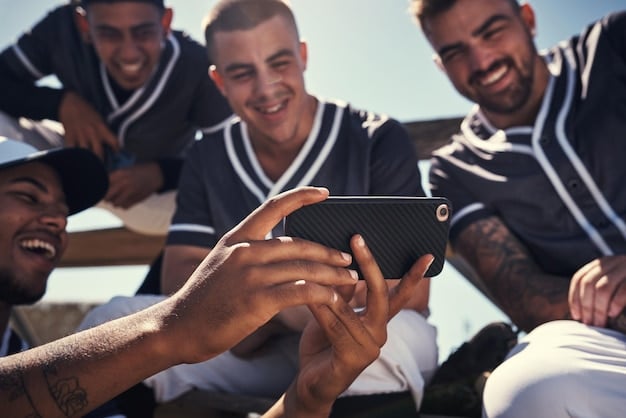Boost Sports Team Fan Engagement & Brand 30% by 2025 via Social Media

Achieving a 30% increase in fan engagement and brand awareness by 2025 for sports teams through social media requires a multifaceted approach, integrating interactive content, strategic partnerships, data analytics, and real-time fan interaction to cultivate a vibrant, loyal digital community.
In the digital age, the roar of the crowd extends far beyond the stadium walls, echoing across social media platforms. For sports organizations aiming to thrive, understanding how can sports teams leverage social Media to engage fans and increase brand awareness by 30% in 2025 isn’t just an aspiration; it’s a strategic imperative. This exploration delves into actionable strategies and innovative approaches that will redefine fan interaction and solidify brand presence in the coming years.
The Evolving Landscape of Fan Engagement
The relationship between sports teams and their fans has fundamentally shifted. No longer are fans passive spectators; they seek active participation, behind-the-scenes access, and authentic connections. Social media platforms, with their unparalleled reach and interactive capabilities, offer the perfect arena to cultivate this dynamic engagement. The push for a 30% increase in both fan engagement and brand awareness by 2025 reflects a recognition of social media’s critical role in modern sports marketing.
This evolving landscape demands more than just posting scores or game highlights. It requires a sophisticated understanding of audience behavior, platform nuances, and content strategy. Teams must move beyond traditional broadcasting to embrace digital storytelling that resonates deeply with their diverse fanbase, fostering a sense of community and belonging that transcends geographical boundaries.
From Broadcast to Conversation: The New Fan Dynamic
The one-way communication model is rapidly becoming obsolete. Fans now expect to be heard, acknowledged, and even co-creators of content. This shift from broadcast to conversation means teams must prioritize two-way interaction, creating spaces where fans can express their opinions, share their experiences, and feel directly connected to their heroes and their club.
- Interactive Content: Polls, Q&As, live streams with players, and fan-generated content challenges.
- Personalized Experiences: Tailored content delivered through algorithms, exclusive access based on engagement levels.
- Community Building: Dedicated fan forums, local fan club promotion, and recognition of loyal supporters.
Understanding these dynamics is paramount. Successful social media strategies for sports teams in 2025 will hinge on their ability to build robust, interactive digital communities. This involves not only pushing out engaging content but also actively listening, responding, and adapting to fan feedback, ensuring a truly reciprocal relationship.
The challenge of achieving a 30% increase is significant, yet achievable, by adopting a data-driven approach coupled with creative content development. Teams must analyze what truly excites their fanbase and replicate those successful formulas while continuously innovating. Emerging platforms and technologies will also play a crucial role in shaping these interactions, demanding flexibility and a willingness to experiment with new engagement formats.
Strategic Content Pillars for Maximum Impact
To capture and sustain fan attention, content strategy must be diverse, compelling, and consistent. It’s about telling a continuous story that captivates followers on various platforms, each with its unique audience and content preferences. The goal is to create a content ecosystem where every piece contributes to the overarching objectives of engagement and awareness.
This means moving beyond game-day updates to encompass a broader narrative that includes player personalities, team values, community initiatives, and historical milestones. A balanced content calendar, featuring a mix of short-form videos, long-form narratives, interactive elements, and user-generated content, will be essential for maintaining a fresh and engaging presence.
Behind-the-Scenes & Player Spotlights
Fans crave authenticity and a glimpse into the unfiltered lives of their idols. Providing exclusive behind-the-scenes content humanizes the team and builds deeper emotional connections. This can range from training ground footage and locker room celebrations to personal interviews and day-in-the-life features on star athletes. These moments offer rare insights that resonate powerfully with the fanbase.
- Training Sessions: Raw footage, skill drills, and team camaraderie.
- Player Interviews: Casual Q&As, personal stories, and challenges.
- Match Day Prep: Pre-game rituals, team talks, and fan interactions.
Such content not only boosts engagement but also reinforces player individuality and team unity, fostering a sense of familiarity and closeness between fans and the organization. It’s about peeling back the curtain to reveal the dedication, passion, and spirit that drive the team forward.
Furthermore, dedicating social media efforts to highlighting individual player journeys, personalities, and charitable work can significantly enhance brand appeal. When fans feel they know the players on a more personal level, their loyalty intensifies. This strategy also provides rich, relatable content that stands out amidst the constant flow of information.
Leveraging Emerging Technologies and Platforms
The digital landscape is constantly evolving, and sports teams must remain agile, ready to embrace new technologies and platforms that offer novel ways to connect with fans. Staying ahead of the curve means experimenting with cutting-edge tools that promise immersive, interactive, and personalized experiences. This proactive approach ensures relevance and sustained growth in fan engagement.
From virtual reality (VR) and augmented reality (AR) to the metaverse and AI-driven personalization, these technologies open up unprecedented possibilities for fan interaction. Early adoption and creative application of these tools can create distinct competitive advantages, setting teams apart in a crowded digital space.
The Metaverse and Beyond: Immersive Fan Experiences
The metaverse, while still in its nascent stages, holds immense potential for sports fandom. Imagine fans attending virtual games, interacting with avatars of their favorite players, or virtually exploring stadiums from anywhere in the world. These immersive experiences transcend traditional viewing, offering a truly interactive and communal digital space.
- Virtual Stadium Tours: Explore the venue, locker rooms, and exclusive areas.
- Digital Collectibles (NFTs): Own unique team memorabilia and virtual assets.
- Fan Meet-ups in VR: Connect with other fans and players in virtual environments.
Beyond the metaverse, augmented reality (AR) can overlay digital information onto the real world, enhancing live game experiences or allowing fans to virtually try on team merchandise. These technologies move beyond passive consumption, transforming fans into active participants in a rich digital ecosystem.
Investing in research and development for these technologies is not just an expenditure; it’s a strategic move towards future-proofing fan engagement efforts. Teams that innovate in this space will be best positioned to capture the next generation of sports enthusiasts, driving both engagement and brand awareness to new heights. The ability to create memorable, unique digital experiences will be a key differentiator.

Data-Driven Fan Insights and Personalization
In the quest for increased engagement and brand awareness, data is the ultimate playbook. By meticulously collecting, analyzing, and interpreting fan data, sports teams can unlock powerful insights into preferences, behaviors, and motivations. This deep understanding enables precision targeting and content personalization, making every fan interaction more relevant and impactful.
From social media analytics to CRM systems, leveraging data goes beyond vanity metrics like likes and followers. It’s about understanding conversion paths, engagement patterns, and the true lifetime value of a fan. This analytical rigor transforms social media from a mere broadcasting tool into a sophisticated platform for strategic marketing and community cultivation.
Unlocking Fan Potential Through Analytics
Sophisticated analytics tools can track everything from optimal posting times and content types to audience demographics and sentiment. This data allows social media managers to refine their strategies continuously, allocate resources effectively, and identify emerging trends before they go mainstream. It’s about making informed decisions rather than relying on guesswork.
- Content Performance: Identify which types of posts generate the most engagement.
- Audience Segmentation: Understand different fan groups and tailor content accordingly.
- Sentiment Analysis: Gauge fan reactions to team performance, players, and announcements.
The insights derived from analytics are invaluable for optimizing content calendars, shaping narrative arcs, and even influencing broader marketing campaigns. A data-driven approach ensures that every social media effort is aligned with strategic objectives, maximizing return on investment and propelling engagement forward.
Personalization, driven by these insights, is the next frontier. Imagine delivering customized news feeds to fans based on their favorite players, preferred content formats, or even their geographic location. This level of tailored interaction fosters a deeper sense of connection and value, directly contributing to loyalty and brand advocacy.
Building Strategic Partnerships and Collaborations
Expanding reach and enhancing brand perception often requires looking beyond internal capabilities. Strategic partnerships and collaborations on social media can introduce the team to new audiences, add fresh perspectives, and create unique content opportunities that might otherwise be unattainable. These alliances are crucial for accelerating growth in both engagement and brand awareness.
From collaborating with influencers and other sports organizations to partnering with brands and local charities, these ventures diversify content, tap into new networks, and amplify messaging. The key is to seek out partners whose values align with the team’s ethos, ensuring authenticity and mutual benefit.
Influencer Marketing and Cross-Promotional Synergy
Influencer marketing, when executed thoughtfully, can be a powerful tool. Partnering with sports journalists, prominent fans, or even celebrities who genuinely support the team can lend credibility and extend reach to their engaged followers. The authenticity of the endorsement is paramount, as discerning fans quickly identify inauthentic promotions.
- Athlete Collaborations: Players creating content on their personal channels, cross-promoting team initiatives.
- Sports Media Partnerships: Joint content creation, live Q&As, and exclusive interviews.
- Brand Collaborations: Co-branded campaigns, contests, and exclusive experiences.
Cross-promotional efforts with other sports leagues, media outlets, or even entertainment entities can also create significant synergy. Joint campaigns can tap into shared fanbases, creating exciting new content formats and driving broader conversations. These collaborations can elevate the team’s profile beyond its core audience, contributing significantly to brand awareness goals.
Moreover, local community partnerships, whether with schools, charities, or businesses, can organically generate positive social media buzz. Showcasing the team’s commitment to its community not only builds goodwill but also creates compelling, feel-good narratives that resonate widely and enhance brand reputation.
Fan-Generated Content and Community Empowerment
One of the most powerful yet often underutilized assets in a sports team’s social media strategy is its own fanbase. Empowering fans to create and share their content not only provides a continuous stream of authentic material but also deepens their sense of ownership and connection to the team. This shift from team-centric content to fan-centric content is a game-changer for engagement and organic reach.
Fan-generated content (FGC) often performs exceptionally well because it comes from a relatable source – fellow fans. It offers diverse perspectives, showcases genuine passion, and carries an inherent authenticity that traditional marketing content sometimes lacks. Encouraging and curating FGC should be a cornerstone of any social media strategy aiming for a 30% increase in involvement.
Igniting the Fan Voice: Contests, Challenges, and Spotlights
Creating clear pathways and incentives for fans to submit content is key. This can be achieved through regular contests, themed challenges, or by simply featuring outstanding fan creations on official team channels. Recognizing and celebrating fan contributions makes them feel valued and encourages further participation.
- Photo/Video Contests: Fans sharing their game-day experiences, fan gear, or creative expressions.
- “Fan of the Week” Features: Highlighting individual loyal supporters and their stories.
- User-Generated Content Challenges: Encouraging fans to recreate famous plays or team chants.
Beyond formal initiatives, actively listening to and amplifying fan conversations on social media is vital. Reposting fan comments, engaging in discussions, and responding to direct messages fosters a sense of being heard and appreciated. This proactive engagement transforms followers into advocates, turning them into powerful, organic brand ambassadors.
The viral potential of FGC cannot be overstated. A single passionate fan video or creative graphic can organically reach millions, cutting through the noise and contributing significantly to brand awareness. By nurturing this community, teams aren’t just gaining content; they’re cultivating a self-sustaining ecosystem of passionate advocates.

Measuring Success and Adapting Strategies for 2025
Setting an ambitious goal like a 30% increase in fan engagement and brand awareness by 2025 demands rigorous measurement and continuous adaptation. Without clear metrics and a commitment to analyzing performance, efforts risk being misdirected. Success relies on defining key performance indicators (KPIs) and regularly reviewing progress against them.
This isn’t a one-and-done strategy; it’s an iterative process. Social media platforms evolve, fan behaviors shift, and new trends emerge. Teams must be prepared to adjust their approaches based on real-time data and insights, ensuring their strategies remain effective and relevant in an ever-changing digital environment.
Key Performance Indicators for Social Media Growth
Beyond vanity metrics, focus on KPIs that directly correlate with engagement and brand awareness. These include reach, impressions, engagement rate (likes, comments, shares per post), website traffic driven by social media, follower growth, and mentions across platforms. Tracking these over time provides a comprehensive picture of performance.
- Engagement Rate: A true measure of how well content resonates with the audience.
- Brand Mentions (Unaided and Aided): Indicates top-of-mind awareness and overall buzz.
- Website Referrals & Conversions: Measures social media’s impact on ticket sales, merchandise, and subscriptions.
Regular reporting and analytics dashboards are essential for visualizing progress and identifying areas for improvement. This data-driven feedback loop allows teams to quickly pivot when strategies aren’t performing as expected or to double down on what’s working well. The agility to adapt is a hallmark of successful digital marketing in 2025.
Furthermore, surveying fan sentiment and conducting focus groups can provide qualitative insights that complement quantitative data. Understanding the “why” behind the numbers refines content creation and strengthens community-building efforts. The fusion of quantitative and qualitative data creates a holistic picture of fan interaction and brand perception, positioning teams for sustained success.
| Key Approach | Brief Description |
|---|---|
| interactivity | Engage fans with polls, Q&As, and live streams to foster two-way communication. |
| Technology Adoption | Embrace AR/VR and metaverse experiences for immersive fan interaction. |
| Data-Driven Personalization | Utilize analytics to tailor content, enhancing relevance and engagement for segmented audiences. |
| Fan-Generated Content | Encourage and feature fan content to boost authenticity and community ownership. |
Frequently Asked Questions
▼
Behind-the-scenes glimpses, player spotlights, and interactive content like Q&As and polls tend to perform exceptionally well. Authenticity and exclusive access foster deeper connections, making fans feel closer to the team and its athletes. Live streams during training or match days also generate high engagement due to their real-time nature.
▼
Teams can use analytics to monitor engagement rates, identify popular content types, understand audience demographics, and track optimal posting times. This data enables A/B testing, personalized content delivery, and strategic adjustments to maximize reach and resonance with specific fan segments, driving overall social media ROI.
▼
Emerging technologies like virtual reality (VR), augmented reality (AR), and the metaverse will offer immersive experiences for fans. These include virtual stadium tours, digital collectibles (NFTs), and interactive fan meet-ups, providing unprecedented levels of engagement and unique opportunities for branded content and community building.
▼
Fan-generated content (FGC) is highly authentic and relatable, often outperforming traditional marketing. It leverages the passion of the fanbase to create organic reach and virality. When fans create and share content, it acts as powerful word-of-mouth promotion, amplifying brand awareness through trusted, peer-to-peer endorsements.
▼
Strategic partnerships, including collaborations with influencers, media outlets, and other brands, are vital for expanding reach and accessing new audiences. These alliances enable cross-promotion, fresh content creation, and shared campaigns that can significantly boost brand visibility and introduce the team to demographics they might not otherwise reach.
Conclusion
The path to significantly increasing fan engagement and brand awareness for sports teams by 2025 is clearly illuminated by the opportunities social media presents. It’s a journey that demands creativity, strategic foresight, and a deep understanding of the evolving digital landscape. Emphasizing authentic interaction, leveraging cutting-edge technology, and empowering the passionate voice of the fanbase are not merely trends but foundational pillars for sustained growth. By embracing these strategies, sports organizations can transform digital connections into tangible loyalty, ensuring their message resonates globally and their brand continues to thrive in an increasingly connected world.





